
1. Specimens / 2. Alvin / 3. Odyssey (l-r)
Hondartza Fraga is a Spanish artist based in Leeds, she is currently doing a PhD at the University of Leeds and was featured in Vitamin D3: Today’s Best in Contemporary Drawing. Court met up with her in her studio for a virtual visit to find out more about what she’s been working on and how she’s found lockdown.
Court Spencer: Hey Hondartza. I know you’re super busy at the moment so thanks for taking time to catch up. I suppose the first thing to talk about would be your practice.
I’ve been aware of your work since the project Curio-sea-ty with Lorna Johnson which included drawing, and then there was 365 Globes where you drew a globe a day for a year, and Beautiful Artefacts, your solo exhibition that formed part of your PhD which included a lot of drawing in relation to the exploration of space. So I suppose I think of your practice as primarily drawing but how do you describe it?
Hondartza Fraga: Yes, alongside drawing I use video, animation and photography. I tend to let each work decide which medium it needs. But drawing is my anchor, the medium I could not do without, the one I miss if I haven’t done if for a while. That was the main motivation behind making 365 Globes [a year-long project where she drew a blank globe each day]. A lot of my work is about places or objects which are far away, and we tend to engage with these through images.
Drawing keeps me grounded somehow and in touch with those images or places, whilst other media seems to perpetuate the distance and detachment. For me, drawing brings the image to the here and now, or at least to ‘my’ here and now.
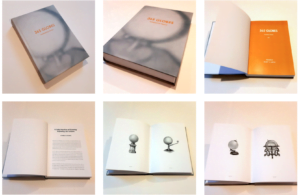
4. 365 Globes
CS: How have you found lockdown? One way you responded was with Beyond Scale, a mini art gallery. Can you tell us a bit about that and are you going to continue it?
HF: In this current lockdown I am amazed how much I managed to do during the first one! Beyond Scale came from an urge to combine two desires: building my own dollhouse and to have my own gallery with a café. With lockdown this indulgence seemed not only permissible but encouraged. It was a ‘now or never’ kind of motivation.
Clearly a lot of people have really felt the absence of physical encounters with people and art and there have been quite a few other mini galleries emerging. I am the only one who enjoys a physical encounter with my mini gallery, but I hope the virtual documentation communicates some of the sense of material and physicality of the miniature. And maybe in the future, the mini gallery can tour or be hosted somewhere for people to see it for real.
I’ve had to take a little break from the mini gallery at the moment, because of added projects and reduced time (childcare again!) but plan to reshow it soon. I started with a solo show of my work and then exhibited works that were naturally small, including paintings by Richard Baker and Sean Williams, models by David Riley and a site-specific installation by Lorna Johnson. They are all on the website so do have a look.
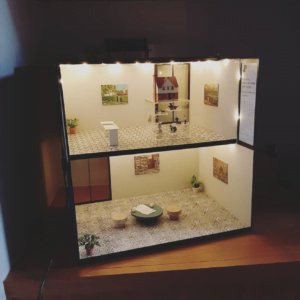
5. Beyond Scale
CS: I’m so pleased you’re going to start programming it again, it was always something I kept an eye out for on my Instagram feed.
Lately you’ve been posting about the work you’ve been making as part of the online Drawing Correspondence course you’re doing. I know you go through phases with social media. Do you feel like it’s played a part in your lockdown experience at all?
HF: I am still finding my way through social media. At the moment I mainly use Instagram as it feels OK to post unfinished works, work in progress, and random stuff on there. My website is a more formal portfolio of finished works but with my PhD I’ve not got as much work that is finished or exhibited, so social media offers an informal space to share what I’m doing.
During 365 Globes I committed to sharing the work there daily and that gave me the encouragement to carry on. In lockdown I guess it became the place to see what others were up to, so it played a sort of surrogate role for the informal sharing we did before in person.
CS: Can you tell us a little about the course and how you’ve found it?

6. Hondartza 1 / 7. Hondartza 2 (l-r)
HF: It is a small group of only ten participants. It’s a fantastic group of people with different interests and experiences. We are coming to the end of the six week course but it came at a perfect time for me as I had hit a bit of a stumbling block with my writing, because of lockdown-related time constraints so I had decided to focus on making and drawing. It has focused me on making but from an open and refreshing perspective.
CS: Earlier this year Phaidon published Vitamin D3, which is described as “an indispensable survey of contemporary drawing”. It features over 100 artists who were nominated by over 70 of the world’s leading art experts. Both you and Tania Kovats who is a tutor on Drawing Correspondence have been included in it. So first of all, a big congratulations, that’s amazing recognition. How did that come about?
HF: Thank you very much, it has certainly been one of, if not THE highlight of my artistic career! I received an email in 2019 saying I had been shortlisted from a longlist of over 500 artists. It was hard not to shout about it right then, but perhaps I was secretly scared that they might change their mind and cut me out of the book! Like an actor who finally gets a speaking part in a movie only to find out at the premiere that their scene was cut! D1 and D2 already sat proudly on my drawing shelf so this was both humbling and encouraging.

8. Vitamin D3 1 / 9. Vitamin D3 2 (l-r)
CS: Are there any trends or developments you see in drawing at the moment?
HF: The thing about drawing is that it’s hard to make singular definitions or sweeping tendencies. Drawing is used in so many ways across disciplines. Drawing research seems to be moving away from trying to define it, and instead focusing on what drawing can do. Drawing is no longer just a subsidiary or preliminary medium, but an established or primary medium, without the need to explain or justify it.
Although, perhaps because of this, I feel there is the risk of over-mythologising drawing. There are many drawing practices today that do not fit with the generalisations made about drawing being quick, expressive, gestural, open-ended and transparent medium. Drawing can be slow, measured, controlled, closed and opaque. Perhaps because drawing is so multi-dimensional it is always hard to define specific trends. I guess the trend is, we are seeing much more of it.
CS: You mentioned earlier that you’ve been installing, are you able to say what the exhibition is?
HF: Yes, it’s a new work commissioned by North Lincolnshire Museum, in Scunthorpe. To celebrate the 200th anniversary of William Smith’s famous geological map from 1815 it has been touring the country and each venue had an artist respond to the map. I was interested in what the map was trying to do, what Smith was interested in, revealing the connections between rocks, revealing the processes of the strata and the way in which those earth layers have formed over time.
The resulting drawings are re-enacting some of those processes, rather than representing them. Inspired by the colours in the map, the colours of the soil around Scunthorpe (which is rich in ironstone), and the marks and forms from the museum’s own collection of fossils, I have used video to reveal the process of the drawings’ formation as a poetic response to the map’s function. The show will open virtually and hopefully will also open for physical visits.
CS: That’s interesting you’re responding to a map. I’m just thinking about a piece you did years ago with a world map that documented the water, 365 Globes and to an extent some of your PhD is mapping sections of space with the available scientific imagery. Would you say maps are a reoccurring interest?
HF: Definitely, I’ve been interested in maps for a long time. Old maps especially, because after they are no longer scientifically accurate, they still hold our interest as beautiful artefacts. They represent our desire to know but also to control, to miniaturise – and I do love miniatures generally! They disclose invisible processes or information, but also leave a lot out. I guess a lot of my work is about looking from a distance, so maps are a particular way of doing that, of looking, measuring and finding our place.
CS: Can you please tell us a little about your PhD?
HF: OK…I’ll try to be brief – haha! So the thematic interest of the research is to revisit the association of the planet Saturn with the notion of melancholy. These two were profoundly connected during the Renaissance but our knowledge and visions of both have changed and I’m interested to find out what this association might look like today, using contemporary resources. My main inspiration is the raw images from the Cassini mission to Saturn, anyone can use these images, just Google it.
The theorical investigation relates to drawing, from an expanded perspective, one that incorporates traditional processes with new digital technologies. I’m interested in exploring the mutually transformative relationship between the techno-scientific images that act as a catalyst and the artistic process of translation, interpretation, deconstruction and reconstruction.

10. Saturn 1 / 11. Saturn 2 / 12. Saturn 3
CS: Are you wanting to go down a more academic route after your PhD?
HF: Not particularly. I’m interested in writing but I’m still refining my own writing voice, especially within an academic framework. I would like to continue with a research driven approach, but always, always, always with the practice leading the way. I cannot imagine I would ever stop making.
CS: Talking of making, for years you made in your space at Patrick Studios but towards the end of 2019 you moved into the studio at your house. On reflection you timed that quite well with lockdown. How have you found working from home?
HF: I know! It was very well timed. Because my stuff was divided between home and the studio, I wasn’t using either properly, hence the decision to bring it all home. It’s the first time in over 10 years that I’ve not had a separate studio, but I love having everything in one place. It’s a dedicated room, so I can leave it a mess and I love being able to pop in at night for a little bit of work here and there.
CS: With so much going on, do you have time to apply for commissions and different opportunities, and if so where do you usually look for those?
HF: Not much time to be honest! I have been looking less because more opportunities have been coming to me. I keep an eye out every now and then, mainly on CuratorSpace, and sometimes people send me links or I see things on social media.
CS: And my final question; as it feels we may be emerging from lockdown, is there anything you’ll take from this experience into your practice going forward?
HF: In terms of my work, the main thing is the need for real-life physical encounters with artworks, and the aspect of touch and the manual act of making. In more general terms, similarly, the need to meet people in real life!
CS: Hondartza thank you so much for your time and for letting me virtually snoop through your studio! I hope the exhibition opens soon in Scunthorpe and I’m going to order myself a copy of Vitamin D3 (and I’m so going to get you to sign it!
Keep up to date with Hondartza’s work here.
Filed under: Art & Photography
Tagged with: art, art studio, artist, drawing, exhibition, gallery, graphic, interview, leeds, Leeds art, lockdown, photography, Saturn, space, Studio
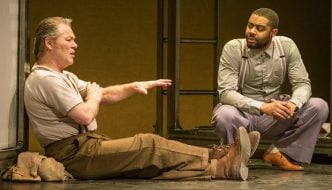
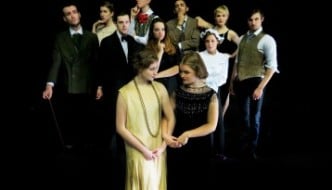
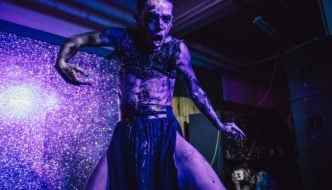
Comments